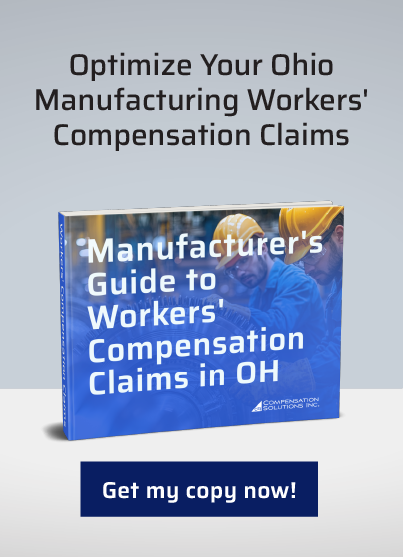OH Workers' Comp for Manufacturing: Self Insured or State Funded?

Few responsibilities are as critical—or as complex—for Ohio manufacturers as workers’ compensation when it comes to protecting your workforce and managing risk. This mandatory coverage ensures that employees who are injured or become ill on the job receive the medical care and wage replacement that they need. It also protects employers from costly litigation.
Ohio operates a unique workers’ compensation system that gives manufacturers two main options: getting coverage through the Ohio Bureau of Workers’ Compensation (BWC), which is state funded, or being self insured. The latter is when a company assumes direct financial responsibility for its own claims. Both offer distinct benefits and challenges. Choosing the right model depends on your organization’s size, financial health, administrative capacity, and risk management strategy.
In this article, we break down the key differences between state-funded and self-insured workers’ compensation models to help you determine the best approach for your manufacturing business.
Understanding State-Funded Workers’ Compensation
For most Ohio employers, the state-funded workers’ compensation system is the default option. It’s administered by the Ohio BWC, which manages claims, collects premiums, and oversees workplace injuries and illnesses across the state.
Definition and Overview
In the state-funded model, employers pay premiums into a pooled insurance fund managed by the BWC. These premiums cover the cost of benefits for injured workers, including medical treatment, wage replacement, rehabilitation services, and death benefits when applicable.
The BWC assumes the role of insurer, handling all claim investigations, benefit payments, and dispute resolutions. This centralized structure provides standardized processes across industries and employer types.
Premiums and Cost Structure
Premiums in the state fund are based on several factors, including:
- The employer’s industry classification, which determines inherent risk levels
- The company’s payroll size
- Claims history, including frequency and severity of past incidents
- Participation in group rating programs or discount incentives
State-funded employers may also qualify for programs that reduce premium costs, such as group-experience rating, group-retrospective rating, and safety incentive programs.
Claims Management and Coverage
A significant feature of the state-funded model is that the BWC manages all claims administration. This includes:
- Filing and processing injury reports
- Determining benefit eligibility
- Approving or denying claims
- Resolving disputes or appeals
Employers have less control over how claims are handled but benefit from the structure and consistency provided by the BWC.
Advantages of the State-Funded Model
- Predictable Costs: Premiums are known in advance and budgeted accordingly.
- Limited Risk: The BWC covers all benefit payouts, reducing financial exposure for employers.
- Administrative Relief: The state manages claims and legal disputes, easing the burden on internal teams.
- Access to Discount Programs: Group rating plans can offer significant cost savings for companies with strong safety records.
Challenges of the State-Funded Model
- Less Control: Employers have minimal influence over the claims process or settlement outcomes.
- Potential Premium Increases: A poor claims history can drive future premiums higher.
- Limited Customization: Standardized processes may not align with a company’s unique risk management goals or workforce needs.
Exploring the Self-Insured Model
For certain manufacturing companies—especially those with robust finances and well-established safety protocols—self-insurance may offer a more strategic and cost-effective alternative to the state-funded model.
Definition and Requirements
Under Ohio law, qualified employers may apply to become self insured. This means they take on the direct financial responsibility of paying workers’ compensation claims. To be approved, companies must:
- Demonstrate strong financial stability.
- Provide detailed risk management procedures.
- Submit to annual reviews by the BWC.
- Purchase excess insurance to cover catastrophic claims.
- Establish an internal or third-party claims administration process.
To be sure, the self-insured route is not for every manufacturer. It is a highly regulated path designed for businesses with the resources and commitment to independently manage the entire workers’ compensation process.
Cost-Savings Potential
A top incentive for self-insuring is the potential for significant cost savings. Instead of paying into the state fund annually, self-insured employers:
- Pay claims as they arise, reducing upfront costs.
- Avoid annual BWC premiums, assessments, and administrative fees.
- Benefit from improved cash flow and long-term financial control.
When managed effectively, self-insurance can lead to lower overall costs, especially for manufacturers with a strong safety culture and low claims frequency.
Risk and Liability Management
With greater financial control comes increased responsibility. Self-insured employers must be prepared to:
- Fund all approved claims, regardless of size.
- Respond to unexpected injuries or lawsuits.
- Stay compliant with all state workers’ compensation regulations.
This model exposes the employer to greater financial risk, particularly in cases involving severe or complex injuries. To minimize liability, a proactive approach to risk mitigation and workplace safety is also required.
Administrative Responsibilities
Self-insuring requires significant operational infrastructure, including:
- Claims management systems and trained personnel or third-party administrators
- Legal and regulatory compliance processes
- Financial reporting and annual self-insurance applications
- Coordination with medical providers and rehabilitation services
- Excess loss coverage to limit exposure from catastrophic claims
While demanding, these responsibilities offer an opportunity for manufacturers to take full control of how claims are handled, often leading to faster resolutions, better employee outcomes, and cost containment.
Pros and Cons of Self-Insurance
Pros:
- Complete control over claims and legal strategy
- Potential for lower long-term costs
- Incentive to improve workplace safety
- Customizable claims and risk management
Cons:
- High financial and administrative burden
- Exposure to unpredictable large claims
- Requirement of dedicated staff or third-party oversight
- Necessity to meet strict BWC approval and reporting requirements
Final Note
Choosing between state-funded and self-insured workers’ compensation isn’t just a financial decision—it’s a strategic one. Manufacturing companies must consider their financial stability, risk tolerance, claims history, and internal capacity to manage complex processes in order to make the most informed and optimal choice determination.
The good news is that when it comes to workers’ compensation in Ohio, manufacturers are not limited to a one-size-fits-all solution. The state-funded model offers a predictable, lower-risk approach with the support of the Ohio BWC, making it ideal for small companies or those with limited administrative resources. Self-insurance presents a compelling opportunity for financially secure manufacturers to reduce long-term costs and take full control of their claims process; it just comes with added responsibility and risk.
Making the right choice may seem daunting, but as a manufacturer, you don’t have to do it alone. Whether you're exploring self-insurance, looking to optimize your current claims management, or simply seeking clarity on your best options, you can access various resources.
Managing workers' compensation claims in Ohio shouldn’t be a headache. Partner with CSI to take the hassle out of claims, lower costs, and stay compliant with Ohio BWC regulations. Focus on your business and employees, and let our seasoned experts guide you through the complexities of workers' comp. Contact us today to streamline the process and experience stress-free claims management!

